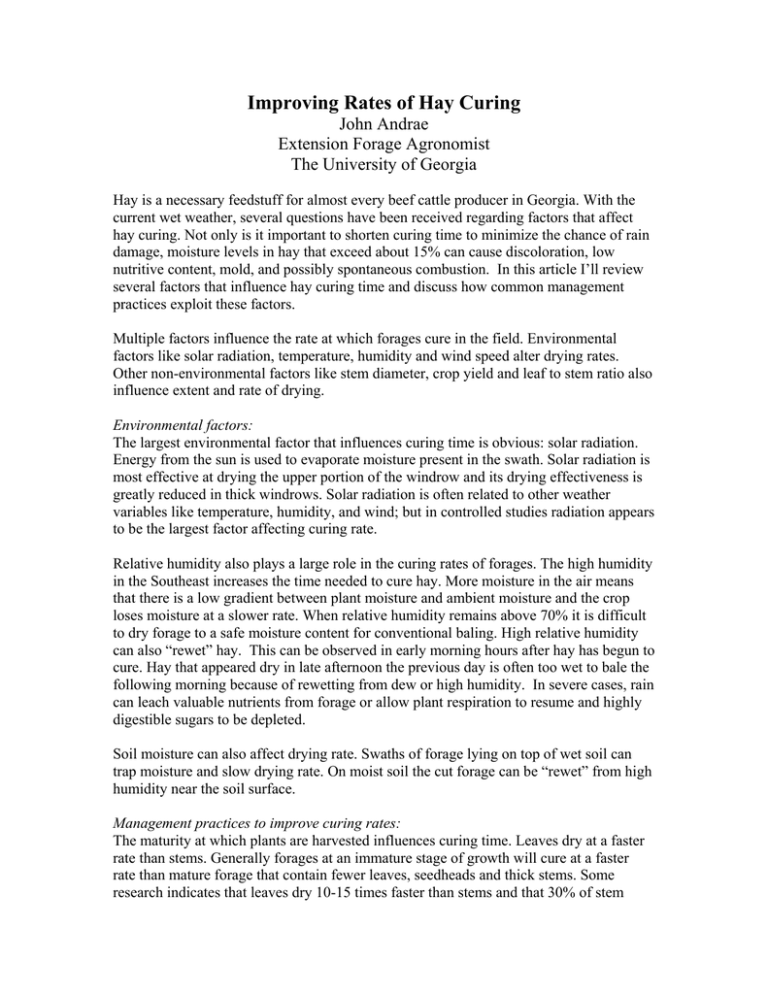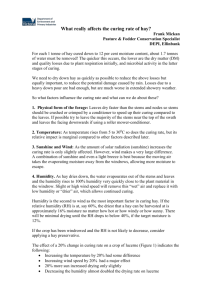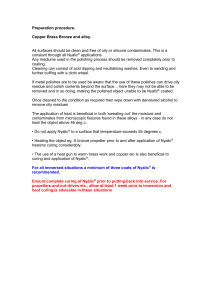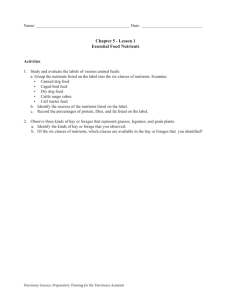Improving Rates of Hay Curing John Andrae Extension Forage Agronomist
advertisement

Improving Rates of Hay Curing John Andrae Extension Forage Agronomist The University of Georgia Hay is a necessary feedstuff for almost every beef cattle producer in Georgia. With the current wet weather, several questions have been received regarding factors that affect hay curing. Not only is it important to shorten curing time to minimize the chance of rain damage, moisture levels in hay that exceed about 15% can cause discoloration, low nutritive content, mold, and possibly spontaneous combustion. In this article I’ll review several factors that influence hay curing time and discuss how common management practices exploit these factors. Multiple factors influence the rate at which forages cure in the field. Environmental factors like solar radiation, temperature, humidity and wind speed alter drying rates. Other non-environmental factors like stem diameter, crop yield and leaf to stem ratio also influence extent and rate of drying. Environmental factors: The largest environmental factor that influences curing time is obvious: solar radiation. Energy from the sun is used to evaporate moisture present in the swath. Solar radiation is most effective at drying the upper portion of the windrow and its drying effectiveness is greatly reduced in thick windrows. Solar radiation is often related to other weather variables like temperature, humidity, and wind; but in controlled studies radiation appears to be the largest factor affecting curing rate. Relative humidity also plays a large role in the curing rates of forages. The high humidity in the Southeast increases the time needed to cure hay. More moisture in the air means that there is a low gradient between plant moisture and ambient moisture and the crop loses moisture at a slower rate. When relative humidity remains above 70% it is difficult to dry forage to a safe moisture content for conventional baling. High relative humidity can also “rewet” hay. This can be observed in early morning hours after hay has begun to cure. Hay that appeared dry in late afternoon the previous day is often too wet to bale the following morning because of rewetting from dew or high humidity. In severe cases, rain can leach valuable nutrients from forage or allow plant respiration to resume and highly digestible sugars to be depleted. Soil moisture can also affect drying rate. Swaths of forage lying on top of wet soil can trap moisture and slow drying rate. On moist soil the cut forage can be “rewet” from high humidity near the soil surface. Management practices to improve curing rates: The maturity at which plants are harvested influences curing time. Leaves dry at a faster rate than stems. Generally forages at an immature stage of growth will cure at a faster rate than mature forage that contain fewer leaves, seedheads and thick stems. Some research indicates that leaves dry 10-15 times faster than stems and that 30% of stem water can be evaporated through the leaves during curing. This is yet another reason to harvest forage at the proper maturity. Tedding or “fluffing” is frequently used to stir or spread the windrow. This stirring moves wetter material to the top of the swath for quicker drying and improves air circulation through the windrow. Tedding can increase drying rate by up to 30% and is especially effective early in the curing process. Tedding crops that are excessively dry can increase leaf shatter particularly when tedders are run at high speeds or in legume containing swards. Raking improves drying rates by helping to invert the swath and move harvested forage onto drier soil for more efficient drying. Raking typically thickens the swath which can decrease drying time if raking is conducted early in the curing process. If hay is raked the morning of baling after the swath has partially dried, improvements of about 15% in drying rates are possible. Mechanical conditioning serves to physically crush stems and create cracks in the plant epidermis or “skin”. This disruption allows moisture to pass from the plant more easily and shortens curing time. Conditioners are essential for many forage crops. The thick and waxy stems of pearl millet and sorghum sudan should be conditioned to speed curing. Success of conditioning, tedding and raking varies widely according to machinery, operating skills, and environmental conditions. In cool and humid conditions, it is difficult to cure forages regardless of these practices. The best response to conditioning, tedding, or raking is when plant or swath characteristics limit drying. Altering the sward may slightly speed curing rate when weather limits curing, but not to the extent as in warm, sunny and dry weather. Remember that curing isn’t everything! Hay management fundamentals still apply. Maintain equipment to minimize breakdowns and shorten time that hay is in the field. Establish and manage productive, disease resistant, high quality varieties. Store hay under shelter when possible. Most importantly, cut hay at the proper maturity. Even the best cured 10 week old bermudagrass hay still has terrible nutritive quality. One of my professors once told our class: “You can take a chance at putting up high quality hay by cutting at the proper time and hoping it doesn’t rain, or you can cut a few weeks later in clear weather and guarantee a low quality crop”. Give that phrase some thought- it’s been over ten years and this statement is still true. While this has not been an exhaustive review of factors that influence hay curing; hopefully it has increased awareness of some of the critical factors and practical constraints of hay curing. If you have further questions regarding managing for high quality hay, feel free to contact your local county agent and visit www.georgiaforages.com. Best wishes for a productive hay season.





